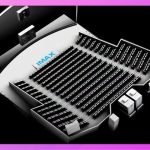Are you a cinephile or planning to watch a new release with friends? If so, you might have come across the terms IMAX and RPX while searching for the best cinemas.
What are IMAX and RPX? Both are theater technologies used in cinemas, but what sets them apart? Let’s delve into a detailed comparison.
I’m sure that by the end of this article, not only will you be able to tell the difference but also know which one is right for you.
Before we move on to the comparison, let’s discuss a bit more about RPX and IMAX;
What is RPX?
RPX is short for Regal Premium Experience. It is one of the most widely used large-screen theatre systems. Its reputation stems from immersive sound effects and top-notch image quality provided by laser projectors.
When Regal released it, their goal was to set a high bar for market competition. And since the RPX format is used in every other cinema, it shows that Regal lived up to their goals.
RPX overshadows the IMAX system with its capability to play every movie format, including 2D and 3D. All in all, it offers better seating and visual experience than any other conventional theatre. It is especially great for dialogue-focused movies.
Pros
- Premium experience
- Less eye-straining screens
- Reclining seats
Cons
- Not as great cinematics as IMAX
- Screens are smaller
What is IMAX?
IMAX abbreviated for “Image Maximum” has made its way through to be the most hyped and advanced theatre proprietary of the modern days. The audio experience takes you into another realm, owing to curved screens and laser projectors.
IMAX outshines the RPX in immersive systems, projector technology, and image optimization but it falls behind in seating and affordability. No other theatre system plays the 3D movie format better than IMAX. The 3D images are presented in unparalleled brightness and quality that takes you out of this world.
However, to experience the true wonders of IMAX, the film should be action-based with thrilling scenes throughout.
Pros
- Bigger curved screens
- 12-channel custom sound systems
Cons
- Not suitable for slow movies because of the brighter screen and louder audio system
RPX vs. IMAX: Comparison Table
| Criteria | IMAX | RPX |
|---|---|---|
| Video quality | The cinematics are highly detailed and crisp with an enchanting 3D effect | Offers amazing video quality |
| Screen size | Less wide but taller than RPX with an aspect ratio of 1:90:1 to 1:45:1 | Screens are wider but shorter in length, (40 x 60 feet) |
| Audio quality | It has a 12-channel advanced Dolby Atmos system where speakers are placed overhead for an immersive audio experience | It features a 7.1-channel audio system, equipped with an Auros or Dolby system that gives you the feel of a personal theatre |
| Comfort | It has premium leather seats which provide the same view to all the people, they aren’t as comfortable as RPX | It has broader reclining seats with extra padding and integrated speakers in the headrests, plus you have enough space to walk around |
| Technology | Features advanced curved screens with 2K and 4K laser projection | Utilizes flat screens with digital projection technology |
| Affordability | A little more expensive than conventional cinemas | Almost the same as IMAX (price may vary according to the seat location) |
| Movie experience | Unmatched video and audio quality | Superior comfort |
| Which is better | It is more suited for action sci-fi and fantasy movies with stunning visuals, not ideal for dialogue-oriented movies | It is great for all movie formats including 2D and 3D |
IMAX vs. RPX: One-on-One Battle Considering All Factors
For all the detail lovers, here is my comprehensive comparison between IMAX and RPX.
Seating Comfort:
Comfort is among the top priorities when choosing a theatre, right? Well, in this regard, RPX trumps IMAX. I’m not saying that the IMAX seating is uncomfortable, the seats have high backs and most of the seats have a leather covering making the whole experience premium.
All of the seats are designed such that you get an unobstructed view, no matter where you sit in the theatre. Equal fun for all!
On the other hand, RPX is at a whole other level when it comes to comfort. They put the viewer’s comfort before everything, offering leather back reclining seats with extra padding.
All the seats have a speaker underneath them to make the experience super hypnotic. Moreover, you have enough space to walk around even with all the seats reclined. So if you’re planning to watch a long movie, 2 hours or more, RPX would be more suitable.
Sound Quality:
The sound quality decides how immersive the experience will be. IMAX rules over RPX when sound is concerned. The reason is the 12-channel sound system and the loudspeakers placed overhead that make the experience more immersive. You get so lost in the sound that you often feel you’re part of the scene, isn’t that amazing?
If we compare the real IMAX with the fake Liemax, there’s no contest – Liemax has compressed audio with unequal distribution. It’s no match for the real IMAX.
Contrarily, the RPX falls just below IMAX in sound quality with 7.1 audio channels and the seats also have embedded speakers. These speakers make the experience more mesmerizing for some people and some find these vibrations disturbing. So it all comes down to your preference.
Video Quality:
With the rise of high fidelity and 4K movies in the modern days, video quality plays a crucial role in your overall experience. So it is very important to choose the right movie format that best suits the kind of theatre system. In this regard, both IMAX
and RPX have their pros and cons.
IMAX is great for 3D action movies packed with thriller cinematics. This is where the vivid image details of IMAX screens come into play. It is also ideal for 2D films because the curved screens have a little 3D effect.
The real IMAX screen uses 4K laser projectors that create an immersive video quality. However, the fake Liemax has 2K projectors that don’t even come close to IMAX in image quality.
As for RPX, it is the best choice for dialogue-oriented movies. The RPX screens are dimmer than IMAX which reduces the eye strain while watching the film. The 3D action movies with stunning visuals don’t look as good because of the low brightness. In the same manner, most of the 2D films don’t look great on RPX because of the flat screens placed at a large distance.
Unlike in IMAX, you won’t have to wear polarized glasses to enhance the 3D effect. Romantic movies like The Notebook would look great on RPX screens.
Technology:
IMAX is the clear winner when it comes to technology. Featuring large curved screens with advanced laser projectors, it presents an unbeatable picture quality. The curved screens create an immersive experience in 3D movies and some crazy video effects even in 2D movies.
Moreover, IMAX uses the 12-channel audio system and 3D and 4D technology. The speakers are installed over the head to provide a balanced sound experience for everyone in the theatre. A shortcoming of IMAX technology is that the movie must be shot using special IMAX cameras.
The RPX gives close competition to IMAX in technology. They’re coming up with innovations all the time to make your cinema experience worthwhile. They released a 4K laser projector with a contrast ratio of 1870:1 and a brightness of 33000 lumens.
Unlike IMAX, in RPX you’ll find the headrest speakers for a more alluring audio experience. Plus, it has reclining seats with additional padding for extra comfort.
Screen Size:
The wall-to-wall curved screens are known for being larger than RPX screens. These screens are almost six times bigger than an average movie screen. They are usually 50 feet tall and 70 to 100 feet long. Thanks to the large size, they create amazing visuals while maintaining a precise contrast ratio.
Some cinemas also have a Liemax or a fake IMAX screen which is usually 22% smaller than the real one. The footage shot for real IMAX also gets cropped. So beware of buying a ticket for the real IMAX.
On the other hand, the RPX screens are usually taller than IMAX screens but they’re not as long. Commonly, RPX screens are 60 feet wide and the length can range from 45 feet to 70 feet.
Despite the size difference, both screens have the same build quality as they are manufactured in the same factory.
Movie Experience:
Now, let’s discuss how is the actual overall experience in both theatres. Well, in IMAX you get an unmatched cinematic experience, owing to the large curved screens and overhead speakers. The visuals are fabulous —no strings attached!
However, RPX puts your comfort before anything. The high-back reclining leather seats are the pinnacle of comfort. The headrests with embedded speakers make the experience way more appealing.
Affordability:
If we compare IMAX with all other conventional cinemas, they’re a bit more expensive. However, RPX ticket prices vary depending on the seat quality and the type of technology (3D, 4K, or laser projector). RPX tickets can even cost more than IMAX. The price difference may be 1$ to 4$ from IMAX.
Similarities Between IMAX and RPX:
IMAX and RPX don’t have many similarities except that they’re modern movie proprietary systems and offer stunning visual and immersive audio experiences. And both systems are getting innovations to enhance the experience of the moviegoers. Other than that, they’re chalk and cheese.
Final thoughts: Which One Should You Go For?
I’ve told you all of the differences between the RPX and IMAX. Now which one should you choose? I can’t answer that for you, it depends on your preference. If you can’t compromise on your comfort and you’re a romantic cinephile, RPX would be better for you.
But if you prefer big screens like me and you’re all about killer cinematic with a hypnotic sound environment. Trust me, you’re going to love IMAX!
If you’re still confused about which one to go for and have a specific movie to watch. Just drop a comment and I’ll sort it out for you.
FAQs
Not at all, actually it’s the opposite. RPX does have a 7.1-channel surround system but it’s not even close to the 12-channel audio system used in IMAX. Up for a Tom Cruise’s banger, IMAX is the way to go.
In general, IMAX screens are larger but it can differ based on your theatre. Usually, IMAX screens are 50 x 70 feet and RPX screens are 40 x 60.
You can get an IMAX ticket for around 19.5$ – 22$, and an RPX ticket can cost you 16.5$ – 21$ ( up to 25$ based on the seat you choose). If these prices sound too much, I’d suggest you keep an eye out for any Tuesday discounts in the cinemas around you.

I’m Shaun Conroy, an audiophile & founder of HiFi Audios. Holding a Bachelor’s in Sound Engineering, I bring deep expertise in audio devices and offer insights & recommendations to fellow enthusiasts.





